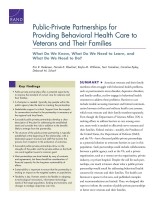| 来源类型 | Research Reports
|
| 规范类型 | 报告
|
| ISBN | 9780833090478
|
| 来源ID | RR-994-NYSHF/MTF
|
| Public-Private Partnerships for Providing Behavioral Health Care to Veterans and Their Families: What Do We Know, What Do We Need to Learn, and What Do We Need to Do? |
| Eric R. Pedersen; Nicole K. Eberhart; Kayla M. Williams; Terri Tanielian; Caroline Batka; Deborah M. Scharf
|
| 发表日期 | 2015
|
| 出版年 | 2015
|
| 页码 | 32
|
| 语种 | 英语
|
| 结论 |
The Report Outlines Nine Key Components of Public-Private Partnerships Relevant for Veteran Behavioral Health - Public-private partnerships offer a potential opportunity to improve the standard of current care for veterans and their families.
- A champion is needed. Typically, key people within the public agency take the lead on creating the partnership.
- Stakeholder support is critical. Support from the nonpublic communities involved in the partnership is necessary at the regional and local levels.
- Successful public-private partnerships develop a clear description of the plan for addressing the established need and consider the risks in addition to the benefits likely to emerge from the partnership.
- The structure of the public-private partnership is typically established at the beginning of the relationship, with a dedicated support structure and staff that monitor the process from inception to the evaluation of outcomes.
- Successful public-private partnerships draw on the strengths of the public and the private entities so that both can work together toward a common goal.
- Most partnerships are time limited by way of contracts and agreements, but there should be consideration of financial capacity for the long-term sustainability of efforts.
- Sustainability is important to ensure that the partnership is making an impact on the targeted systems or populations.
- Flexibility is key. Partners need to be flexible in adapting to technological innovations, information technology, needs of the target population, funding environments, and changes to strategic objectives over time.
|
| 摘要 |
- Establish a clear definition of a successful public-private partnership.
- Conduct rigorous research on public-private partnerships.
- Adopt a continuous quality-improvement framework into public-private partnerships.
- Make clear funding allocations to evaluate programs and obtain data to support future sustainability efforts.
- Expand on established community-based public-private partnerships.
- Encourage organizations to seek out public-private partnerships to meet their goals.
|
| 主题 | Health Care Access
; Health Care Delivery Approaches
; Mental Health Treatment
; Military Families
; Veterans Health Care
|
| URL | https://www.rand.org/pubs/research_reports/RR994.html
|
| 来源智库 | RAND Corporation (United States)
|
| 资源类型 | 智库出版物
|
| 条目标识符 | http://119.78.100.153/handle/2XGU8XDN/108060
|
推荐引用方式
GB/T 7714 |
Eric R. Pedersen,Nicole K. Eberhart,Kayla M. Williams,et al. Public-Private Partnerships for Providing Behavioral Health Care to Veterans and Their Families: What Do We Know, What Do We Need to Learn, and What Do We Need to Do?. 2015.
|
|
文件名:
|
x1495316321552.jpg
|
|
格式:
|
JPEG
|

|
文件名:
|
RAND_RR994.pdf
|
|
格式:
|
Adobe PDF
|
除非特别说明,本系统中所有内容都受版权保护,并保留所有权利。